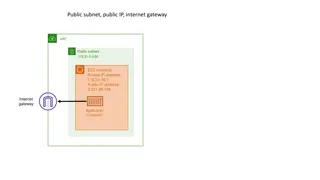Comprehensive Guide to Nexus vPC: Definitions, Benefits, Terminology, Operation, Consistency Check, Configuration
This comprehensive guide covers everything you need to know about Nexus vPC (Virtual Port Channel) including definitions, benefits, terminology, operation, consistency checks, and detailed configuration steps. Explore the virtual port channel concept and its impact on network topology, spanning tree protocol, peer-keepalive connectivity, port channels, and more.
Uploaded on Oct 10, 2024 | 0 Views
Download Presentation

Please find below an Image/Link to download the presentation.
The content on the website is provided AS IS for your information and personal use only. It may not be sold, licensed, or shared on other websites without obtaining consent from the author.If you encounter any issues during the download, it is possible that the publisher has removed the file from their server.
You are allowed to download the files provided on this website for personal or commercial use, subject to the condition that they are used lawfully. All files are the property of their respective owners.
The content on the website is provided AS IS for your information and personal use only. It may not be sold, licensed, or shared on other websites without obtaining consent from the author.
E N D
Presentation Transcript
Cisco Support Community Presents Tech-Talk Series Nexus vPC (Virtual Port Channel) Vivek Ruhil Pradeep Malik Vinay Kumar CCIE SP #40530 CCIE R&S, SP #25302 CCIE R&S #35210 Advance Services Advance Services HTTS
vPC Definition Virtual Port Channel L2 Si Si Si Si Logical Topology Physical Topology vPC Non-vPC
Benefits of vPC STP Domain vPC Domain SW1 SW2 SW4 SW5 STP Failure SW3 SW6
vPC Terminology vPC Peer-keepalive link vPC Domain vPC peer-link CFS protocol vPC peer vPC vPC vPC Orphan Ports member port port member vPC vPC member port
vPC Operation MAC_C MAC_C 1 5 N7K-2 N7K-1 N7K-2 N7K-1 5 2 3 N5K-2 N5K-1 N5K-2 N5K-1 4 CFS 2 6 3 1 MAC_A MAC_A
vPC Consistency Check Type 1 Type 2
vPC Configuration Following steps are needed to build a vPC (Order does Matter!) Define domains Establish Peer Keepalive connectivity Create a Peer link Reuse port-channels and Create vPCs Make Sure Configurations are Consistent 1 2 3 4 5 6 7 8 vPC member Routed Interface Host Port
vPC Configuration Contd. N7K2-LAB (config )#feature vpc N7K2-LAB (config )#vpc domain 10 N7K2-LAB (config-vpc-domain)# peer-keepalive destination N7K-1-IP N7K2-LAB (config-vpc-domain)#system-priority 2000 N7K2-LAB (config-vpc-domain)#role priority 500 ! N7K2-LAB (config)# interface port-channel 10 N7K2-LAB (config-if)# vpc peer-link ! N7K2-LAB (config)# interface ethernet2/2 N7K2-LAB (config-if)# channel-group20 N7K2-LAB (config)# interface port-channel 20 N7K2-LAB (config-if)# vpc 20 N7K1-LAB (config )#feature vpc N7K1-LAB (config )#vpc domain 10 N7K1-LAB (config-vpc-domain)# peer-keepalive destination N7K-2-IP N7K1-LAB (config-vpc-domain)#system-priority 2000 N7K1-LAB (config-vpc-domain)#role priority 1000 ! N7K1-LAB (config)# interface port-channel 10 N7K1-LAB (config-if)# vpc peer-link ! N7K1-LAB (config)# interface ethernet2/2 N7K1-LAB (config-if)# channel-group20 N7K1-LAB (config)# interface port-channel 20 N7K1-LAB (config-if)# vpc 20 SW-LAB (config)# interface ethernet2/2 SW-LAB (config-if)# channel-group20 ! SW-LAB (config)# interface ethernet1/2 SW-LAB (config-if)# channel-group20 ! SW-LAB (config)# interface port-channel 20 -- Normal Configuration --
vPC Verification N7K-LAB(config)# show vpc brief N7K-LAB(config)# show vpc peer-keepalive vPC keep-alive status : peer is alive --Peer is alive for --Send status --Last send at --Sent on interface --Receive status --Last receive at --Received on interface : mgmt0 --Last update from peer vPC Keep-alive parameters --Destination --Keepalive interval --Keepalive timeout --Keepalive hold timeout : 3 seconds --Keepalive vrf --Keepalive udp port --Keepalive tos Legend: (*) - local vpc is down, forwarding via vPC peer-link : (310) seconds, (29) msec : Success : 2013.08.14 11:42:00 176 ms : mgmt0 : Success : 2013.08.14 11:42:01 5 ms vPC domain id Peer status vPC keep-alive status Configuration consistency status : success vPC role Number of vPC configured : 10 : peer adjacency formed ok : peer is alive : primary : 1 : (0) seconds, (818) msec : 10.0.0.2 : 1000 msec : 5 seconds vPC Peer-link status --------------------------------------------------------------------- id Port Status Active vlans -- ---- ------ -------------------------------------------------- 1 Po10 up 1,11,35,99 : management : 3200 : 192 vPC status ---------------------------------------------------------------------- id Port Status Consistency Reason Active vlans -- ---- ------ ----------- -------------------------- ------------ 20 Po20 up success success 1,11,35,99 show vpc role show vPC statistic peer-keeplive show vpc consistency-parameters show vpc consistency-parameters interface port-channel 20
vPC Design Recommendation Recommendation for vPC Peer Link Recommendation for vPC Peer Keep-alive Link Recommendation for vPC Member Ports 1. Port-channel mode: on, off, or active 1. The vPC Peer Link should be formed of a minimum of 2 x 10GE links on separate linecards 1. Dedicated Link (1Gbps is sufficient) using dedicated VRF 2. Link speed per channel 2. mgmt0 interface (shared link with management traffic) 3. Duplex mode per channel 2. The 10GE ports should be configured to operate in dedicated bandwidth mode 4. Trunk mode per channel 3. Routed over L3 infrastructure (least preferred) 3. Configure vPC Peer Link ports as STP 'Network' ports to enable Spanning Tree Bridge Assurance on these links (assuming BA is enabled globally). 5. Native VLAN 6. VLANs allowed on trunk 7. Tagging of native VLAN traffic 4. Enable UDLD on vPC Peer Links 8. Spanning Tree Protocol (STP) mode ,Interface & global Settings 5. Running a dedicated VLAN / SVI across the peer link to cater for uplink failure (e.g. to the core) may also be desirable. 9. STP region configuration for Multiple Spanning Tree 10. Enable/disable state per VLAN 11. Loop & Root guard 12. Bridge Assurance setting 13. Port type setting-We recommend that you set all vPC interfaces as network ports 14. Maximum Transmission Unit ( MTU )























